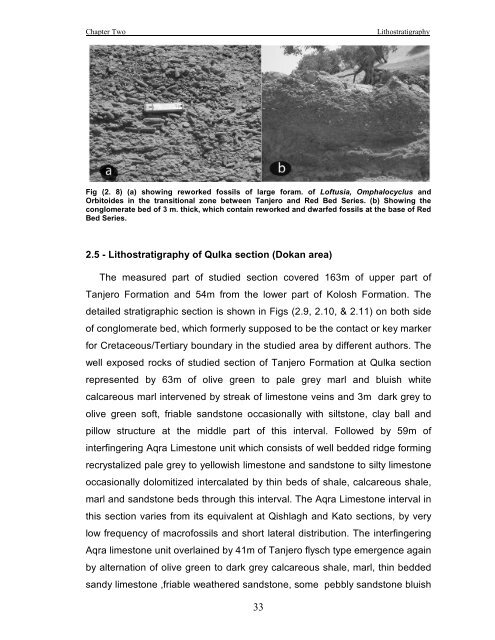biostratigraphy and paleoecology of cretaceous/tertiary boundary in ...
biostratigraphy and paleoecology of cretaceous/tertiary boundary in ...
biostratigraphy and paleoecology of cretaceous/tertiary boundary in ...
Create successful ePaper yourself
Turn your PDF publications into a flip-book with our unique Google optimized e-Paper software.
Chapter Two<br />
Lithostratigraphy<br />
Fig (2. 8) (a) show<strong>in</strong>g reworked fossils <strong>of</strong> large foram. <strong>of</strong> L<strong>of</strong>tusia, Omphalocyclus <strong>and</strong><br />
Orbitoides <strong>in</strong> the transitional zone between Tanjero <strong>and</strong> Red Bed Series. (b) Show<strong>in</strong>g the<br />
conglomerate bed <strong>of</strong> 3 m. thick, which conta<strong>in</strong> reworked <strong>and</strong> dwarfed fossils at the base <strong>of</strong> Red<br />
Bed Series.<br />
2.5 - Lithostratigraphy <strong>of</strong> Qulka section (Dokan area)<br />
The measured part <strong>of</strong> studied section covered 163m <strong>of</strong> upper part <strong>of</strong><br />
Tanjero Formation <strong>and</strong> 54m from the lower part <strong>of</strong> Kolosh Formation. The<br />
detailed stratigraphic section is shown <strong>in</strong> Figs (2.9, 2.10, & 2.11) on both side<br />
<strong>of</strong> conglomerate bed, which formerly supposed to be the contact or key marker<br />
for Cretaceous/Tertiary <strong>boundary</strong> <strong>in</strong> the studied area by different authors. The<br />
well exposed rocks <strong>of</strong> studied section <strong>of</strong> Tanjero Formation at Qulka section<br />
represented by 63m <strong>of</strong> olive green to pale grey marl <strong>and</strong> bluish white<br />
calcareous marl <strong>in</strong>tervened by streak <strong>of</strong> limestone ve<strong>in</strong>s <strong>and</strong> 3m dark grey to<br />
olive green s<strong>of</strong>t, friable s<strong>and</strong>stone occasionally with siltstone, clay ball <strong>and</strong><br />
pillow structure at the middle part <strong>of</strong> this <strong>in</strong>terval. Followed by 59m <strong>of</strong><br />
<strong>in</strong>terf<strong>in</strong>ger<strong>in</strong>g Aqra Limestone unit which consists <strong>of</strong> well bedded ridge form<strong>in</strong>g<br />
recrystalized pale grey to yellowish limestone <strong>and</strong> s<strong>and</strong>stone to silty limestone<br />
occasionally dolomitized <strong>in</strong>tercalated by th<strong>in</strong> beds <strong>of</strong> shale, calcareous shale,<br />
marl <strong>and</strong> s<strong>and</strong>stone beds through this <strong>in</strong>terval. The Aqra Limestone <strong>in</strong>terval <strong>in</strong><br />
this section varies from its equivalent at Qishlagh <strong>and</strong> Kato sections, by very<br />
low frequency <strong>of</strong> macr<strong>of</strong>ossils <strong>and</strong> short lateral distribution. The <strong>in</strong>terf<strong>in</strong>ger<strong>in</strong>g<br />
Aqra limestone unit overla<strong>in</strong>ed by 41m <strong>of</strong> Tanjero flysch type emergence aga<strong>in</strong><br />
by alternation <strong>of</strong> olive green to dark grey calcareous shale, marl, th<strong>in</strong> bedded<br />
s<strong>and</strong>y limestone ,friable weathered s<strong>and</strong>stone, some pebbly s<strong>and</strong>stone bluish<br />
33

















